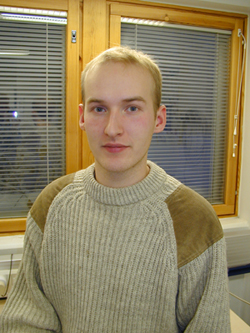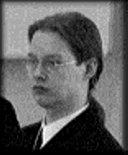Second
Medical Physics and Medical Engineering Day
|
||||
|
Osteoarthrosis is a very common and progressive musculoskeletal disorder, characterised by the degenerative structural changes in the articular cartilage and underlying subchondral bone. Among the first signs of cartilage degeneration are the decrease in tissue proteoglycan (PG) concentration and disorganization of the type II collagen network. These changes make cartilage softer and prone to irreversible degeneration. Current clinical techniques, i.e. arthroscopy, radiography and MRI are relatively qualitative and, obviously, not optimal to detect the earliest signs of cartilage degeneration. The aim of this thesis was to develop and validate a novel technique and instrument, which combines ultrasound and mechanical (indentation) measurements. The development of the instrument aimed towards arthroscopic use. In ultrasound indentation of articular cartilage, a small 10 MHz ultrasound transducer was used as a compressive indenter and the the stress induced onto the tissue was detected with the strain gauge technique. With the 500 MHz AD-converter a resolution of 1.6 µm was reached for the determination of cartilage deformation. The performance of the instrument was tested with elastomer and bovine articular cartilage samples in vitro. Cartilage samples (n=17) were tested before and after enzymatic degradation by trypsin (major PG and minor collagen degradation), chondroitinase ABC (PG degradation) and collagenase (collagen degradation). The tissue thickness was calculated as a product of the time-of-flight and the speed of sound value. Finally, the the effect of speed variation on the measured parameters was numerically simulated using an analytic model of cartilage indentation. The instrument was capable of measuring thickness and dynamic modulus of elastomers and cartilage reliably. Trypsin and collagenase induced a mean decrease of -31.2±12.3% (±SD, p<0.05) and -22.9±20.8% (p=0.08) in dynamic modulus, respectively. The creep rate (deformation speed under constant stress) increased as a function of decrease of the PGs (trypsin: +117.8±71.4%, p<0.05; chondroitinase: +24.7±35.1%, p=0.17). Ultrasound reflection from the articular surface decreased after tissue collagen damage (collagenase: -54.2±29.6%, p<0.05; trypsin: -17.1±13.5%, p=0.08). Reproducibility (standardized coefficient of variation) of the measurement parameters was typically 1-10%. The maximum detected decrease in the sound speed (-3.6%, collagenase sample) induced an error of +3.7% on the thickness and an error of +0.04% on the dynamic modulus provided that the change in the speed of sound is ignored. With the novel instrument, the decrease of the cartilage proteoglycan content and the destruction of the cartilage collagen network were sensitively and specifically revealed. This is important, since the PG content may be modified e.g. by adequate exercise, whereas the collagen network damage is irreversible. The instrument will be designed for routine arthroscopic use, enabling rapid quantitative screening of all patients having arthroscopy. This enables preventive actions prior to permanent degeneration. |
||||
Jussi Aarnio, Helsinki University of Technology
|
||||
|
Trans skull ultrasound therapy has been possible after the development of phased array technology. Variable skull thickness causes phase differences to sound waves as they propagate through skull and therefore phased arrays need phasing information for each of the transducer elements in order to gain a focus in brain. At the moment there are not a simple ultrasound method for determining acoustic phase shift non-invasively. The aim of this work was to develop a simple and completely non-invasive method that can be used to acquire phasing information for phased arrays in trans skull therapies. In the new method an ultrasound transducer is used to send a short pulse to the skull bone, and reflection is recorded. Spectrum of the received signal shows minima at resonant frequencies of the skull. The phase shift caused by the skull can be calculated from this information. The method was tested with single layer plastic plates, with three layer plastic phantoms and with 3 human ex vivo skullcaps. Results are compared to the hydrophone measured phase shifts. Measurements were done with a single element transducer and with multi-element transducer array designed for trans skull therapies. In addition to experiments the effects of water temperature gradient on phase measurements was simulated. Experiments with single layer plastic plates showed an average difference of 12.2° between pulsed ultrasound method and hydrophone method, and 52.4° with three-layer plastic phantoms. With skulls the average difference between two modalities was 35.1° in measurements done with the single element transducer and 39.0° for the skull measured with the multi-element array. In simulations it was noted that temperature gradient of 2°C in water temperature can cause up to 23° difference in phase for most distant elements in multi-element transducer array. Results from experiments with plastic plates and skulls show that phase shift can be determined reliably with pulsed ultrasound. In case of plastic phantoms results are promising as well, because the standard deviation of measured phase differences was only 9.6° showing a near equal offset in each case between two modalities. In measurements with multi-element array part of acquired data had to be left outside of analysis because of poor signal. This was mainly a consequence of different geometry between skull and hemisphere array. Two modalities differ the most in skulls, as expected, the standard deviation being 23.3° in single element and 23.6° in multi-element transducer experiments. The main reason for bigger deviation in the case of skull is its complicated structure. |
 |
|||
Marco Casagrande, Helsinki University of Technology
|
||||
|
There are many adhesion molecules that mediate lymphocyte rolling and firm adhesion by forming molecular bonds. In this work some adhesion molecules have been introduced. These adhesion molecules are present and functional in the leukocyte adhesion cascade. Furthermore, some models that describe the kinetics of bond formation and breakage have been reviewed in this paper. The first part of this work includes a closer look into flow dynamics and the flow chamber, which is often used in studying cell adhesion. Studying the strength of the adhesion bonds and particularly comparing these forces in physiologic and pathologic conditions is scientifically and diagnostically valuable. The focus of this project was to find out, if the optical tweezers are a suitable tool in measuring adhesion forces. Adhesion forces have been studied using different tools and methods, but optical tweezers have not been used in lymphocyte adhesion measurements. 1064 nm Nd:YAG-laser was used to form the first optical tweezers. The force that these tweezers could exert to lymphocytes was 15±5 pN. This force was not strong enough to detach the attached lymphocytes. Even the rolling lymphocytes did not react in any way to the tweezer force. In order to strenghten the tweezers, the laser was switched to 800 nm Ti:Sa-laser, which had maximum output power 10-times bigger than the Nd:YAG-laser. By using Ti:Sa-laser it became possible to create optical tweezers that were 5 times more powerful. The force exerted on the lymphocytes was measured to be 80±15 pN. These powerful tweezers were still not able to detach the firmly adhered lymphocytes, but at full power, part of the rolling lymphocytes stopped rolling and could be captured as they entered the optical trap. The original intention to study the dynamics of firm adhesion was not possible, because the adhesion forces exceeded the maximum force of the tweezers. In the last part of the work, focus was on the study of lymphocyte rolling. The goal was to find out if there were differences in rolling forces between three different cell lines: VAP-1-positive, mutant VAP-1-positive and VAP-1-negative endothelial cells. In the measurements made, significant differences between the cell lines could not be shown, but an estimate for the rolling forces regarding lymphocytes and HUVEC-endothelial cells was derived. 70 % of the rolling lymphocytes could be trapped and stopped when the force of the tweezers was 65 pN and 100 % when the force was over 80 pN. |
 |
|||
Antti Happonen, Tampere University of Technology
|
||||
|
Tomography is a method which gives information from inner structures of an object without breaking it. The most common application of tomography is medicine. In tomography, resulting measurement is called a sinogram. It is not an image of measured object but projections through it with equally spaced distances 0 - 180 degrees. Mathematically, tomography is modeled by the Radon-transform. The sinogram has to be reconstructed to the image using an approximation of the inverse Radon-transform. A less noisy sinogram would alleviate the ill-posed problem. Sinogram filtering is not an easy task. Commonly used filtering methods applied to the sinogram domain cause spatially varying blurring to the reconstructed image or do not fully exploit the sinogram's spatial dependency of the adjacent projections. In this M.Sc. thesis, a new sinogram filtering method based on the "stackgram" domain without above drawbacks is presented. The stackgram concept based on an idea to find and filter all sinogram's sinusoidal loci which form the sinogram. This can be achieved by transforming the sinogram to the three dimensional stackgram domain consisting of a stack of back-projected projections. This is an interpolation problem. In the stackgram domain, the sinusoidal loci are straight lines parallel to the vertical axis of the stackgram. These signals are filtered in order to get the filtered sinogram. After filtering, the stackgram is transformed back to the sinogram domain. The new method was tested and compared to the sinogram domain filtering by simulated data using Gaussian filter and by PET data using wavelet denoising. The stackgram domain offers a robust domain to filter the sinogram. In addition, the stackgram domain filtering does not cause geometrical distortions to the reconstructed image. |
 |
|||